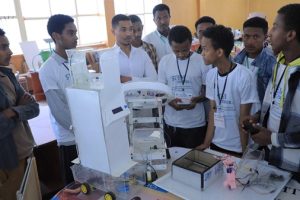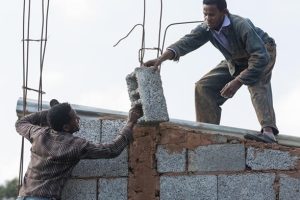
- On Thursday, the ‘Unity Park’, which is a manifestation of the MEDEMER (synergy) idea, has been inaugurated in the presence of the diplomatic community, ambassadors, representatives of UN agencies, ministers and other invited guests.
- According to Prime Minister’s office, the Unity Park is a manifestation of the Abiy’s philosophical idea called MEDEMER, and build upon for future generations. It will harness people’s unity to come together for a common goal.
Apart from this, the park will be one of source of revenue for the country being used as a tourist destination. Its ticket price to visit the park is 200 Birr, and for VIP, it is 1,000 Birr.
A number of African leader arrived in Ethiopia on Thursday to grace the official inauguration of the newly refurbished Unity Park, found in the restored National Palace, in the heart of Addis Ababa. Among those leaders are Kenyan President Uhuru Kenyatta, Ugandan President Yoweri Museveni, South Sudan President Salva Kiir and Somali President Mohamed Abdullahi.
Built some 130 years ago during Emperor Menelik, the Unity Park is established in 2019 which lies on a 40 hectares plot at the Grand Palace in Addis Ababa, Ethiopia, a compound that has been a seat of state for more than a century.
The park accommodates a zoo, pavilions that showcase cultural and historical assets of Ethiopia, traditional garden, residences, halls and chapels.
Banquet Hall
The Banquet Hall or commonly called ‘Gibir Adarash’, was built during the reign of Emperor Menelik II. When it was constructed, it had a capacity to entertain almost 8,000 guests at a time. Emperor Menelik used to organize feasts three times a week, not to mention the plentiful carousals during festive days. In 1963 following the establishment of the Organization of African Unity (OAU), Emperor Haile Selassie had organized a feast for the founding fathers of OAU in this same Hall. In 2019 Prime Minister Abiy Ahmed, had arranged a 5 million Birr dinner as part of raising money for the project ‘Beautification of Addis Ababa’.
The “Throne Hall” or “Throne House”
The “Throne Hall” or “Throne House” as it is also known is where Ethiopia’s monarchs would meet with the provincial lords of aristocratic backgrounds and royal lineage to discuss local issues and make important decisions on subjects such as land tax. On special occasions, the space was also used to welcome nobles and foreign dignitaries. Queen Elizabeth II of British, Charles De Gul of France and Joseph Broz Tito of Yugoslavia were only few of the distinguished world leaders to be received in this Hall during the reign of Emperor Haile Selassie.
During the Dergue regime the Throne House served as a meeting hall for the Derg Central Committee in which numerous matters were deliberated, including the famous rural land expropriation proclamation and the decision to kill high officials of Emperor Haile Selassie. The Throne Hall is highly decorated with precious stuccos covering the walls and ceiling. It takes its name from the large, golden throne displayed in the center.
There are plinths featuring the Star of David, the symbol of the Solomonic Dynasty, at the base of the columns supporting the canopy holding the crown. At the top, statues of angels extend their arms, expressing praise. Currently, the “Throne Hall” houses the main exhibition of Unity Park museum. The exhibition celebrates the history and culture of Ethiopia, a nation shaped by its ethnic and religious identities and its politics. It traces Ethiopia’s evolution through legends, cultural beliefs, various governments, and historical events. Some of which took place here in Menelik Palace.
Menelik II’s Palace Complex
Menelik Palace Complex refers to the octagonal structure and other collection of historical buildings that were built at the time of Emperor Menelik II. This Complex consists of private prayer room of Emperor Menelik II and the Emperor’s watching tower, Emperor Menelik II’s Office, Menelik IIʼs Bedroom and Reception Room, Etege Taytu Betul’s Bedroom, the Minister of War’s Waiting Room, The Princes’ Bedroom, Council of Ministers and a small banquet hall. The first telephone for the entire country was also installed to this building.
Ethiopian Regional States Pavilion
Ethiopian Regional States Pavilion is an attraction that displays cultural, historical, natural and other assets of the regional states of Ethiopia at a glimpse. The cultural, historical, natural resources and investment opportunities of all regions are presented in a short video, pictorial displays and different sculptures.
Traditional Garden
This area is devoted to demonstrate different indigenous plants and traditional building styles of the rural Ethiopia to visitors. In this garden, mainly, different indigenous plants that can be utilized as medication, ornament, spice, food and beverage production, and furniture production are planted. In addition, it demonstrates the livelihood of the rural community, building styles, and the rural landscape in a very symbolic and fascinating way. Different sculptures made of wood, mud houses, houses made of stone and wood are fascinating features of the garden. Being handmade is the special feature of this traditional garden. Each feature has used local knowledge without the intervention of any machine. Different professionals skilled in curving, stone wall construction and other traditional skills have participated entirely.
Ethiopian Zoo (Black-maned Lion Zoo)
This section of the park is dedicated for preservation and exhibition of diverse types of fauna and flora of the country. Over 20 species of animals and plantations are parts of this extraordinary zoo.
African Zoo
- African Zoo comprises of 40 species and 312 individual animals and plantations from all over Africa. It also constitutes an aquarium. The Zoo aims at preserving and exhibiting these unique African fauna and floras. Visitors should have with them a valid identification document and should strictly abide by the rules and preconditions to be able to visit the park.
- The Ethiopian Herald October 12/2019
- BY ZELALEM GIRMA





